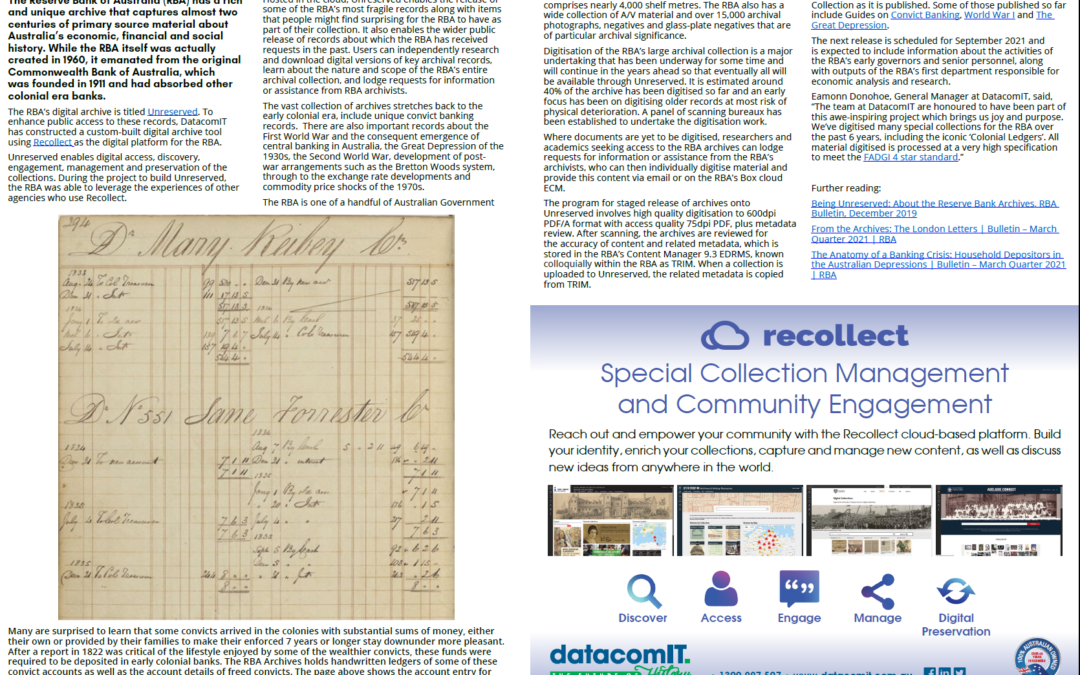The Reserve Bank of Australia (RBA) has a rich and unique archive that captures almost two centuries of primary source material and Australia’s economic, financial and social history. While the RBA itself was actually created in 1960, it emanated from the original Commonwealth Bank of Australia, which was founded in 1911 and had absorbed other colonial era banks.
The RBA digital archive is titled Unreserved. To enhance public access to these records, DatacomIT has constructed a custom-built digital archive tool using Recollect as the digital platform for the RBA.
Unreserved enables digital access, discovery, engagement, management and preservation of the collections. During the project to build Unreserved, the RBA was able to leverage the experiences of other agencies who use Recollect.
Hosted in the cloud, Unreserved enables the release of some of the RBA’s most fragile records along with items that people might find surprising for the RBA to have as part of their collection. It also enables the wider public release of records about which the RBA has received requests in the past. Users can independently research and download digital versions of key archival records, learn about the nature and scope of the RBA’s entire archival collection, and lodge requests for information or assistance from RBA archivists.
The vast collection of archives stretches back to the early colonial era, include unique convict banking records. There are also important records about the First World War and the consequent emergence of central banking in Australia, the Great Depression of the 1930s, the Second World War, development of post-war arrangements such as the Bretton Woods system, through to the exchange rate developments and commodity price shocks of the 1970s.
The RBA is one of a handful of Australian Government agencies to retain custody of its records by agreement with the National Archives of Australia. Its many information physical documents are stored in a central purpose-built repository beneath the Head Office building in Sydney that comprises nearly 4,000 shelf metres. The RBA also has a wide collection of A/V material and over 15,000 archival photographs, negatives and glass-plate negatives that are of particular archival significance.
Digitisation of the RBA’s large collection is a major undertaking that has been underway for some time and will continue in years ahead so that eventually all will be available through Unreserved. It is estimated around 40% of the archive has been digitsed so far and early focus has been on digitising older records at most risk of physical deterioration. A panel of scanning bureaux has been established to undertake the digitisation work.
Where documents are yet to be digitised, researchers and academics seeking access to the RBA archives can lodge requests for information of assistance from the RBA’s archivists, who can then individually digitise material and provide this content via email or on the RBA’s Box cloud ECM.
The program for staged release of archives onto Unreserved involves high quality digitisation to 600 dpi PDF/A format with access 75dpi PDF, plus metadata review. After scanning, the archives are reviewed for the accuracy of content and related metadata, which is stored in the RBA’s Content Manager 9.3 EDRMS, known colloquially within the RBA as TRIM. When a collection is uploaded to Unreserved, the related metadata is copied from TRIM.
Major release of digitised records are expected to occur twice-yearly and will be accompanied by corresponding Series and Research Guides. The RBA’s archivists are creating detailed Research and Series Guides for each Collection as it is published. Some of those published so far include Guides on Convict Banking, World War I and The Great Depression.
The next release is scheduled for September 2021 and is expected to include information about the activities of the RBA’s early governors and senior personnel, along with outputs of the RBA’s first department responsible for economic analysis and research.
Eamonn Donohoe, General Manager at DatacomIT, said, “The team at DatacomIT are honoured to have been part of this awe-inspiring project which brings us joy and purpose. We’ve digitised many special collections for the RBA over the past 6 years, including the iconic ‘Colonial Ledgers’. All material digitised is processed at a very high specification to meet the FADGI 4 star standard.”

